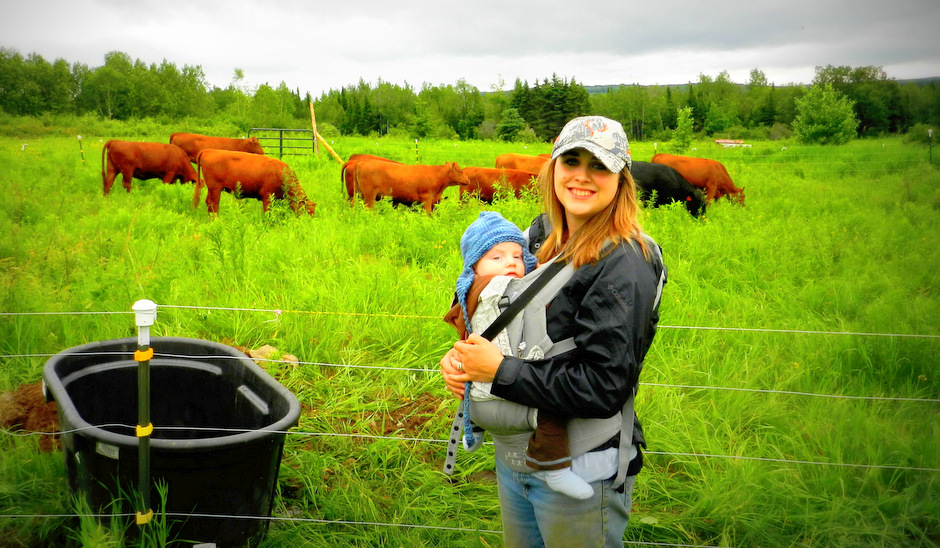
with a yearling black Angus bull.
We are starting off our Cattle Breeding blog series with a discussion on deciding your breeding season.
Please click here to see our introductory post to our Cattle Breeding series.
Developing a successful breeding program takes many years and careful thought and consideration into the genetics you want in your herd.
Deciding the timeline for your breeding season is an important step for every breeder and one that needs to be given a lot of careful consideration.

Born on April 28, 2014
Here on our farm, we are in the midst of our very first calving season, with 4 of our expected 10 calves born.
We are anxiously awaiting the births of the rest of our calf crop.

Last spring, we were anxiously awaiting the arrival of our first herd of beef cattle -10 red Angus heifers. We still had a month or so to go before they arrived but we already had cattle on the mind.
We needed to decide when we wanted our breeding season to start. We pored over pictures we had taken in the past month, looking for that transition from winter to spring, snow to green grass. We needed to decide when our breeding season would start and for how long it would last.

One of the pictures we looked at when deciding when we wanted calving to start.
After considering the weather and analyzing our pictures, we decided we wanted our calving season to start in late-April/early-May of the following spring. We planned on the snow essentially being gone, and the grass starting to green-up at this time. This put us at starting our breeding season in mid-July, for a 60-day breeding season. We felt it was important to have a definitive start and end date to our breeding season, as to give us the most accurate prediction of when calving would start. Perhaps more importantly, having all calves born in a tight window of time makes for a more uniform and saleable calf crop.
By not knowing when your actual breeding season is, you leave yourself open to a lot of surprises and very little clue as to when or even if, your animals will calve. For some farmers, they have an open-breeding season, where the bulls have access to the heifers and cows year-round. Others restrict access of the bulls to a certain window of time, such as a 30 or 60-day period.
It can be tricky to complete natural breeding in only 30 days, but certainly not impossible for the seasoned breeder. After years of developing a solid and consistent breeding program, with superior genetics, these breeders continue to have high pregnancy rates and a large crop of healthy calves on the ground each year.
For the beginning farmer and breeder, though, a 30-day breeding season may not be realistic. It certainly was not for us. For example, if you are breeding a yearling bull(s) to heifers, they may need a few cycles to successfully breed. Heifers and cows are in estrus or standing heat (open to being bred) on average every 21 days. There is a short window of time for the bull to act once the cow comes into heat (typically 12-18 hours), though. Therefore, your first-time bull may not get the job done the first time or even if the females appears to have been bred, the pregnancy may not take or be viable.
Perhaps a 60-day breeding season may be more appropriate for your program. During the span of a 60-day breeding season, you animals should cycle two, if not three, times.
Some questions to ask yourself when deciding the time-frame for your breeding season.
When do you want your calves to start dropping?
- You need to consider the weather conditions and the scope of your farm.
- Do you have the facilities to accommodate calving during a snowstorm, in the middle of winter, with -30 temperatures? Even the most seasoned and equipped farmer can lose calves in these conditions.
- Consider the typical weather and ground conditions for the time of year you want to calve. You might still be calving in a snowstorm (our first calf) even though spring has supposedly arrived
Consider the pros and cons to early-versus-late calving
Advantages to Early Spring Calving
- Calves have more days for growth and weight gain
- Higher weaning weight for your feeder calves
- Higher yearling weight for your replacement heifers and/or additional heifers.
Disadvantages/Challenges with Early Spring Calving
- Need the proper equipment and facilities to accommodate early calving, especially during inclement weather
- More calves lost due to cold winter conditions, crowded facilities and muddy yards
- Higher feed cost to keep cows in adequate physical condition to have healthy calves and breed back on time.
Advantages to Late Spring / Summer Calving
- Warm weather and green grass are great for calf health and survival
- Barns, shelters and other facilities less necessary
- Lower feed cost due to availability of green grass
- Better breed-back rates closer to summer solstice
Disadvantages/Challenges with Late-Calving
- Shorter period of time for growth and weight gain (smaller calves in the fall)
How long of a breeding season do you want?
- 30 and 60-days are common breeding season lengths. Some breeders may extend to 90-days or simply keep the bull with the herd year-round.
Leave a Reply